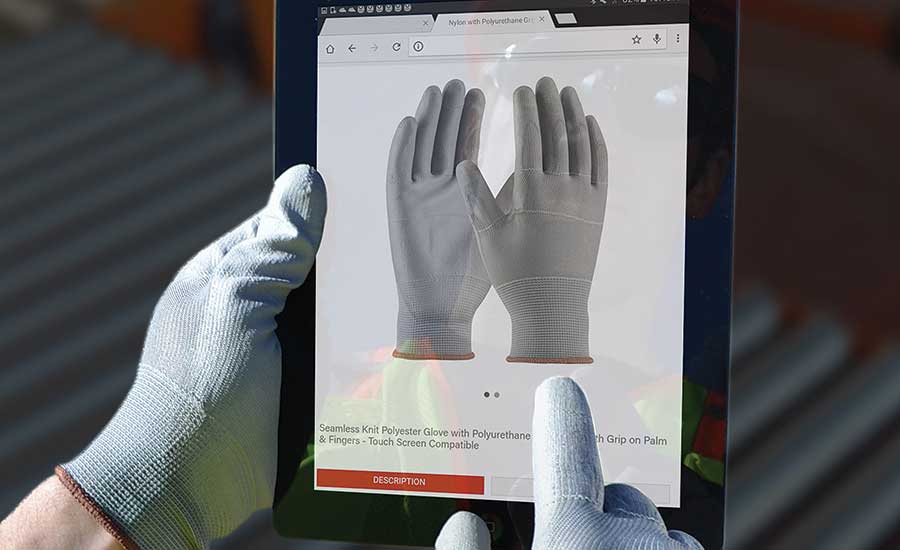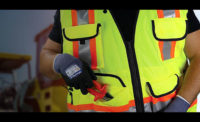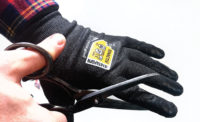A big question when selecting work gloves today is touchscreen compatibility. Understanding what constitutes touchscreen compatibility is not straightforward and there is more to it than just the glove.
First and foremost, we need to correct a common misconception that touchscreens work based on heat from fingers. It’s not heat that generates touchscreen functionality, instead, most screens work either on finger pressure applied or electrical field disruption. Basically, this means there are two main types of touchscreen technologies.
Resistive touchscreen
Resistive touchscreens are the most common type found on industrial controls. A resistive touchscreen has two transparent layers separated by a thin gap. These two layers have a conductive coating on the device’s internal sides which both face each other. When these two layers of coating touch each other, a voltage is passed, which is in turn processed as a touch in that location. Because of this, one only needs to create a local pressure point to initiate a signal regardless of whether their fingers are bare or gloved. Resistive touchscreens are durable and reliable, but can only handle one touch point at a time — ruling out multi- touch gestures like two-finger zoom and swipe command motions, synonymous with smartphones, tablets and newer laptops. It is, however, easy to understand why resistive technology is the first choice for most touchscreen controls found on industrial machinery.
Capacitive touchscreen
Unlike resistive touchscreens, capacitive screens do not rely on finger pressure. Instead, they work with anything that holds an electrical charge — including human skin. Our skin is comprised of atoms with positive and negative charges. Capacitive touchscreens coated with materials like copper or indium tin oxide, store electrical charges in an electrostatic grid of tiny wires — each thinner than a human hair. When there is finger contact with the screen surface, it changes electric fields and affects the capacitance. The processor determines the location of the electrical field disruption and commands are executed.
Variables to consider
Understanding this, one can logically assume that capacitive touchscreens will not work with most gloves and certainly not with any coated gloves. But, correlation is also not quite so straightforward. Randomly trying different coated gloves on your smartphone will demonstrate that some will activate the screen to varying degrees of performance. Why is this the case?
First, it clearly depends on the screen itself, physical properties like capacitance of the elements, drive signals and performance of the processor. Second, as noted above, the mechanism for capacitance applies to anything that affects the electric field on the surface of the screen. So, while most glove coatings are not intentionally developed to achieve a level of dielectric performance, some of the coating compounds tested provided a measurable level of conductivity that may be enough to affect the electric fields on a touchscreen, which depending on fingertip pressure and/or time, will have an effect on screen functionality and responsiveness. Think of how fingertip pressure can compress the coating to a very thin layer at the contact point – enough to affect the electric fields. Furthermore, as if all of this wasn’t complicated enough, most gloves with a black coating contain an inherently semi-conductive carbon material. The mere presence of carbon black allows many coated gloves to work at varying degrees of functionality with different tablet and smartphone screens.
Variations in glove performance
Based on our testing, we’ve concluded that most disposable gloves and thinner coated seamless knit gloves will work with tablets or smartphones. We do, however, caution that there are noticeable variations, with some requiring a little more pressure or response time. We’ve found that large touchscreens, such as those found on newer laptops, are responsive with disposable gloves, but may not do well with coated seamless knit gloves. Touchscreens used on smaller devices such as tablets and smartphones are among the most sensitive. To avoid further issues with smartphones or tablets where fast precision swiping and scrolling is required, we recommend coated gloves with thin, non-tacky coatings. For less sensitive touchscreens, such as those found on laptops, we suggest the use of coated knit gloves that feature conductive fingertips designed to perform to bare-finger precision. (We remind you that all conductive tips will wear out after prolonged use.)
As the last point, it is important to mention that ill-fitting or wrong-sized gloves with fingers that are too long are unlikely to work. The excess material or air gap trapped in the tips will only serve to distance the electrical field rendering the gloves inoperative on touchscreens.
Bottom line
One can clearly understand now that glove touchscreen compatibility is not as simple as it seems. While we could make all our gloves with conductive fingertips, it would increase costs for a feature that only a small percentage of workers may need. In this article, we’ve learned three very important points:
First, most screens on modern industrial machines use resistive technology that work via light finger pressure and hence will work with any glove.
Second, most black-coated gloves will work with a majority of the capacitive touchscreens because they contain carbon black material that is inherently semi-conductive. Because it is semi-conductive, their effectiveness varies, based on the thickness of the coating.
Third, when someone asks: “Is this glove touchscreen compatible?,” the best answer is: Most black-coated work gloves are technically touchscreen compatible. However, since there are different types of touchscreens with varying degrees of touch responsiveness, only by trying it will you be able to determine if it will work with your touchscreen. Let’s begin by first selecting the glove for your work application and then we will test for touchscreen compatibility.






